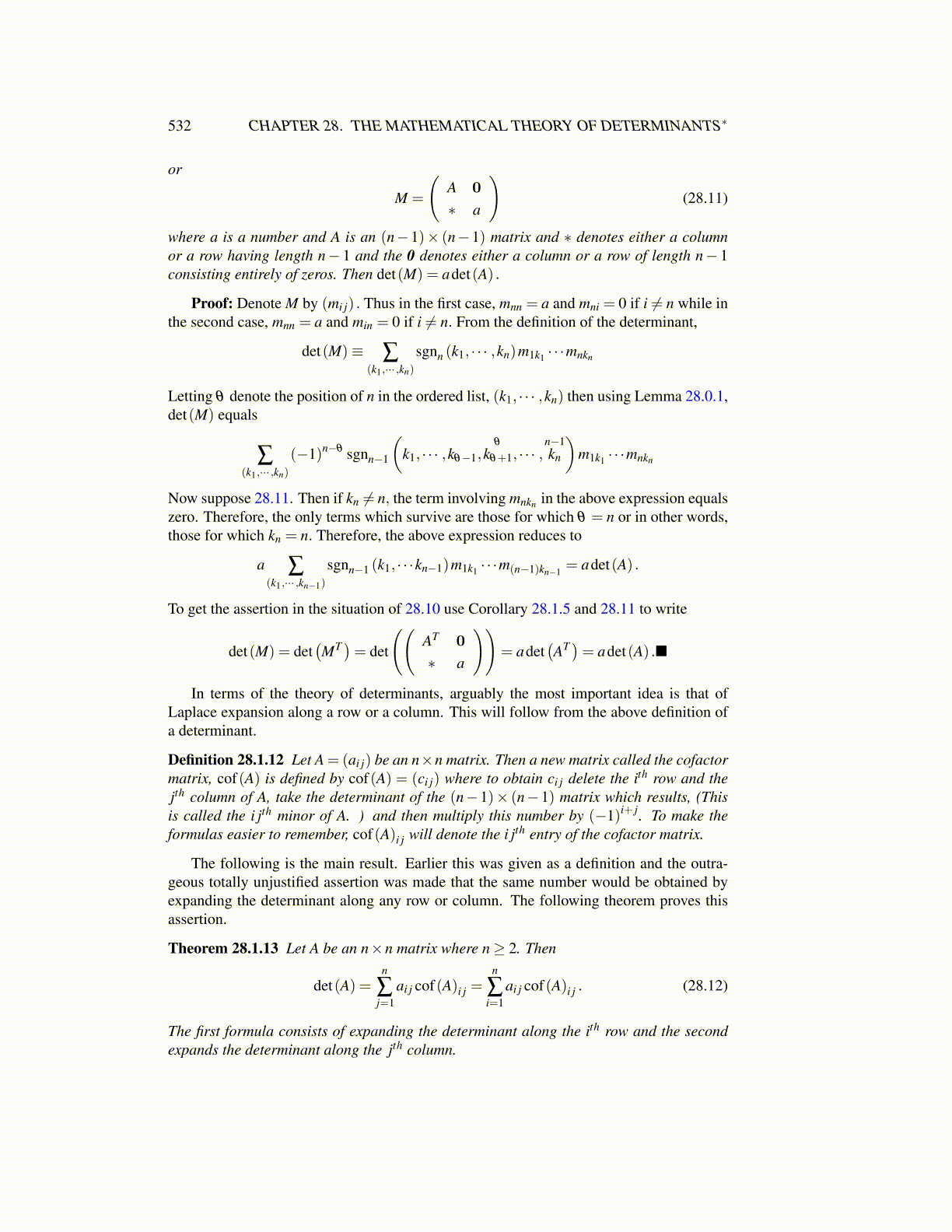
532 CHAPTER 28. THE MATHEMATICAL THEORY OF DETERMINANTS∗
or
M =
(A 0
∗ a
)(28.11)
where a is a number and A is an (n−1)× (n−1) matrix and ∗ denotes either a columnor a row having length n− 1 and the 0 denotes either a column or a row of length n− 1consisting entirely of zeros. Then det(M) = adet(A) .
Proof: Denote M by (mi j) . Thus in the first case, mnn = a and mni = 0 if i ̸= n while inthe second case, mnn = a and min = 0 if i ̸= n. From the definition of the determinant,
det(M)≡ ∑(k1,··· ,kn)
sgnn (k1, · · · ,kn)m1k1 · · ·mnkn
Letting θ denote the position of n in the ordered list, (k1, · · · ,kn) then using Lemma 28.0.1,det(M) equals
∑(k1,··· ,kn)
(−1)n−θ sgnn−1
(k1, · · · ,kθ−1,
θ
kθ+1, · · · ,n−1kn
)m1k1 · · ·mnkn
Now suppose 28.11. Then if kn ̸= n, the term involving mnkn in the above expression equalszero. Therefore, the only terms which survive are those for which θ = n or in other words,those for which kn = n. Therefore, the above expression reduces to
a ∑(k1,··· ,kn−1)
sgnn−1 (k1, · · ·kn−1)m1k1 · · ·m(n−1)kn−1 = adet(A) .
To get the assertion in the situation of 28.10 use Corollary 28.1.5 and 28.11 to write
det(M) = det(MT )= det
((AT 0
∗ a
))= adet
(AT )= adet(A) .■
In terms of the theory of determinants, arguably the most important idea is that ofLaplace expansion along a row or a column. This will follow from the above definition ofa determinant.
Definition 28.1.12 Let A = (ai j) be an n×n matrix. Then a new matrix called the cofactormatrix, cof(A) is defined by cof(A) = (ci j) where to obtain ci j delete the ith row and thejth column of A, take the determinant of the (n−1)× (n−1) matrix which results, (Thisis called the i jth minor of A. ) and then multiply this number by (−1)i+ j. To make theformulas easier to remember, cof(A)i j will denote the i jth entry of the cofactor matrix.
The following is the main result. Earlier this was given as a definition and the outra-geous totally unjustified assertion was made that the same number would be obtained byexpanding the determinant along any row or column. The following theorem proves thisassertion.
Theorem 28.1.13 Let A be an n×n matrix where n≥ 2. Then
det(A) =n
∑j=1
ai j cof(A)i j =n
∑i=1
ai j cof(A)i j . (28.12)
The first formula consists of expanding the determinant along the ith row and the secondexpands the determinant along the jth column.